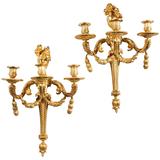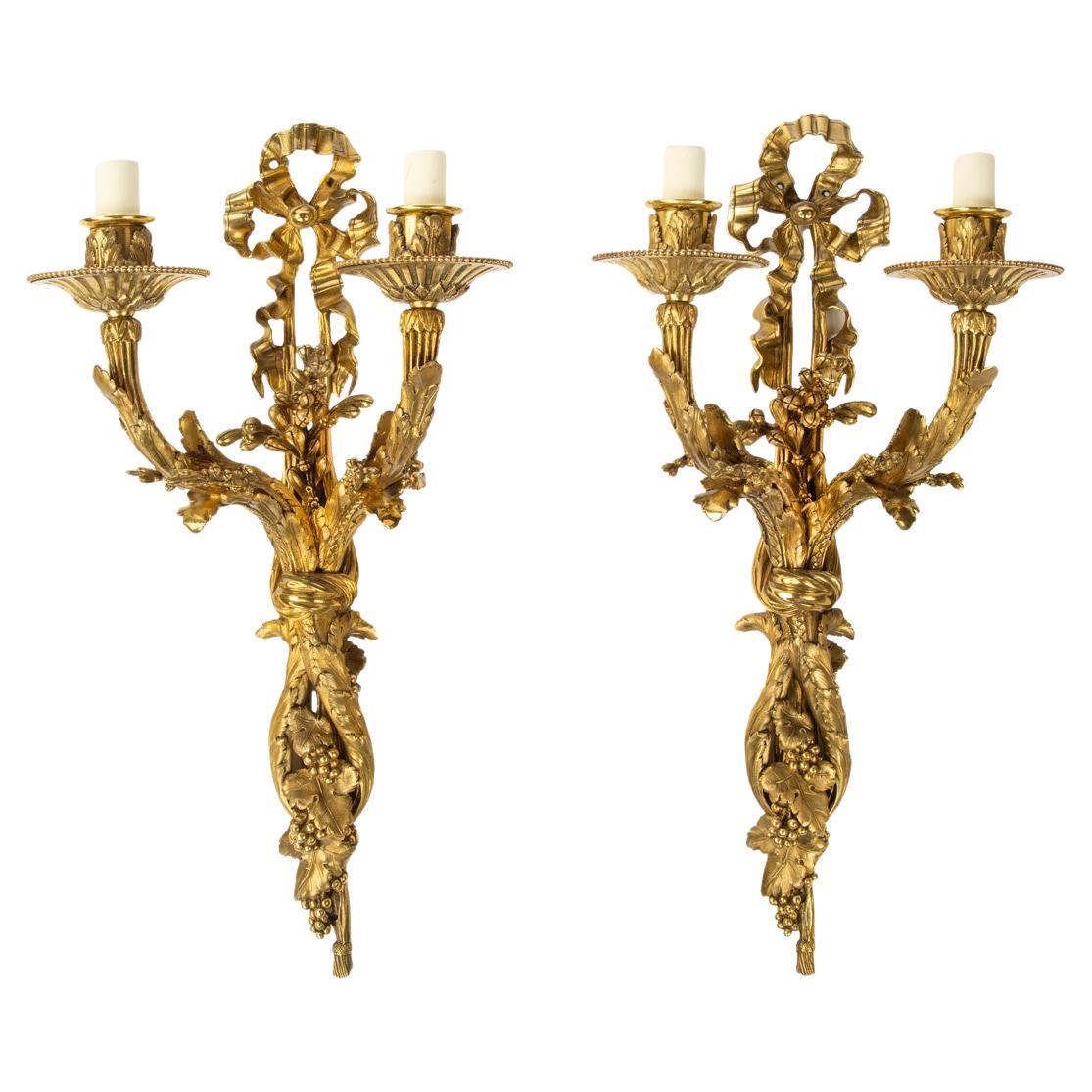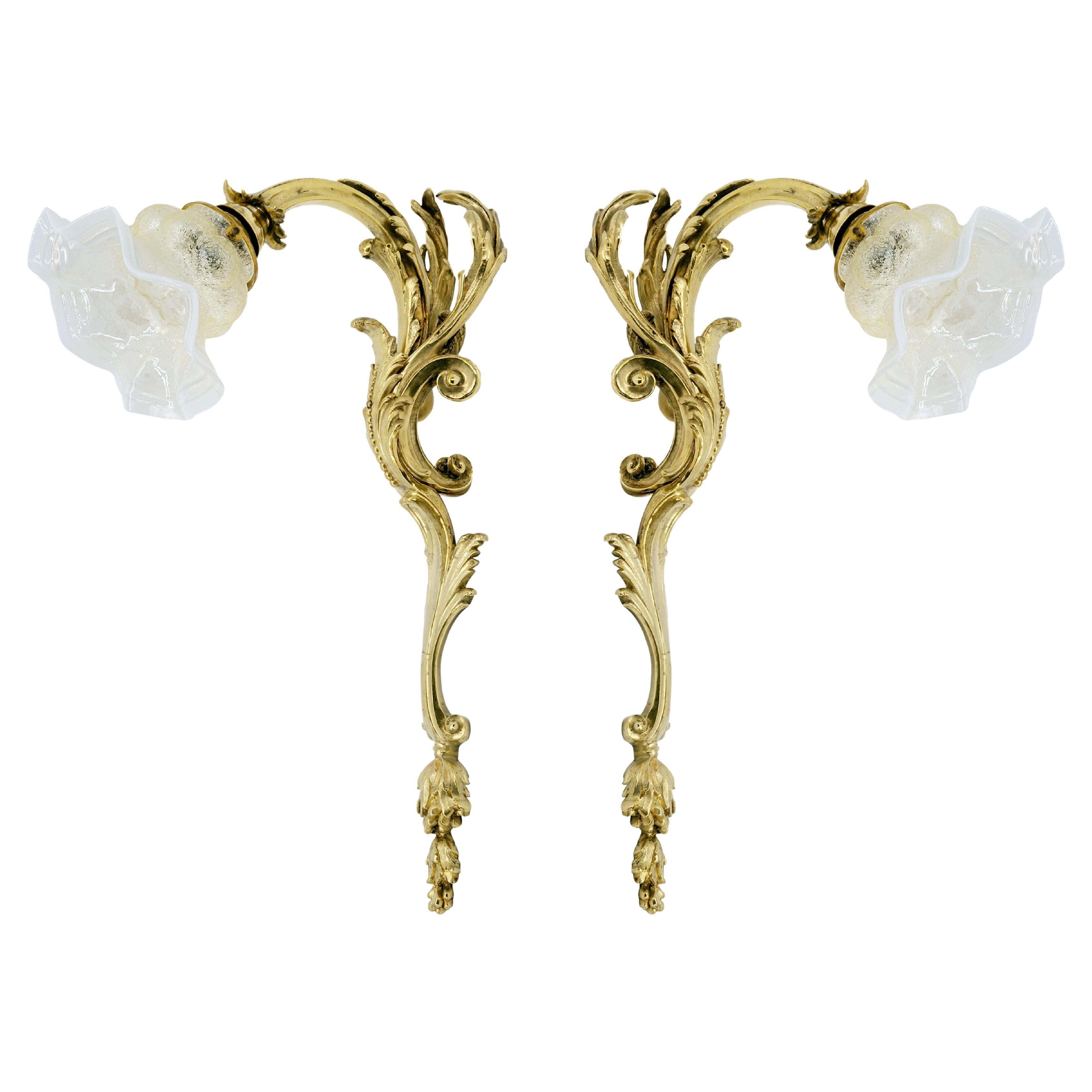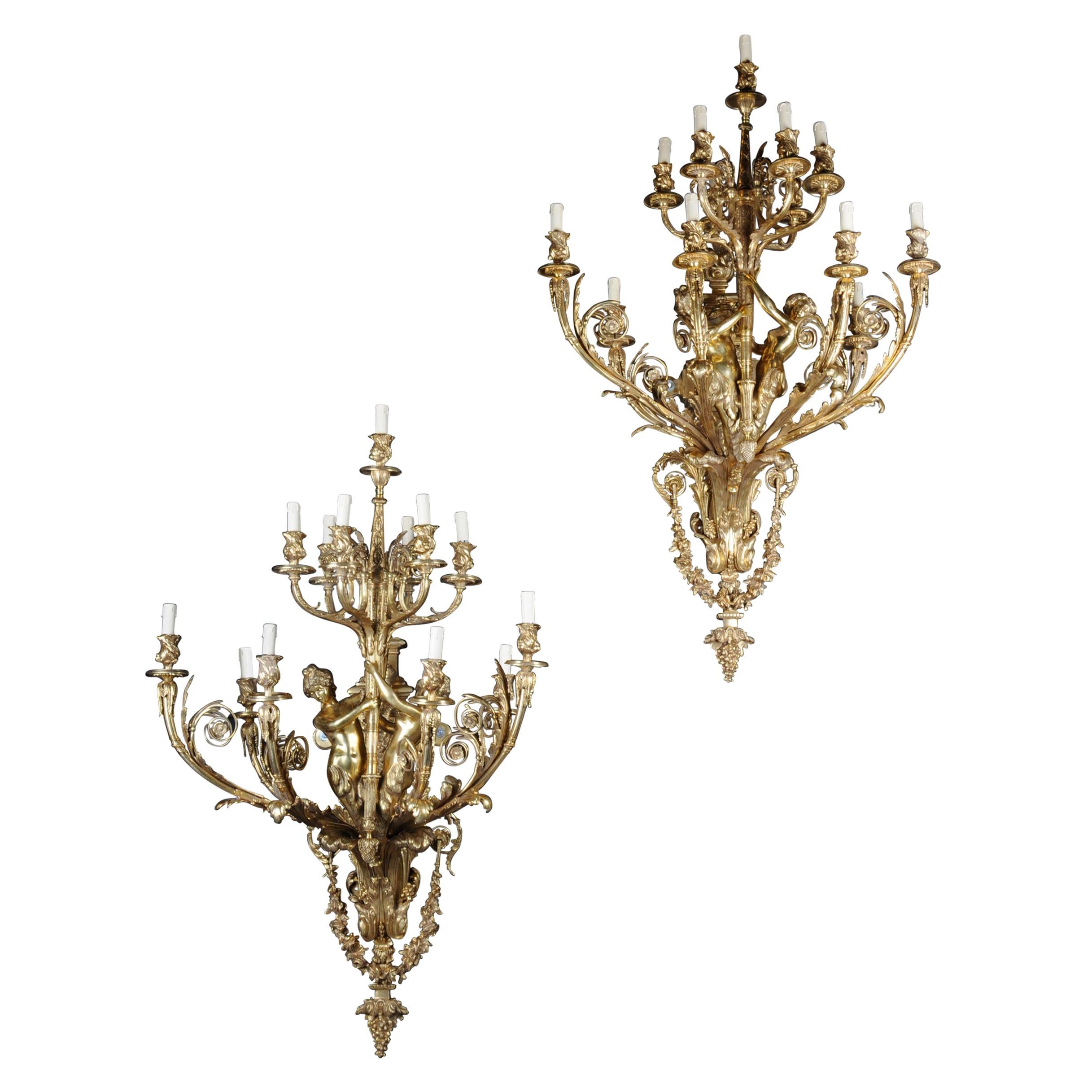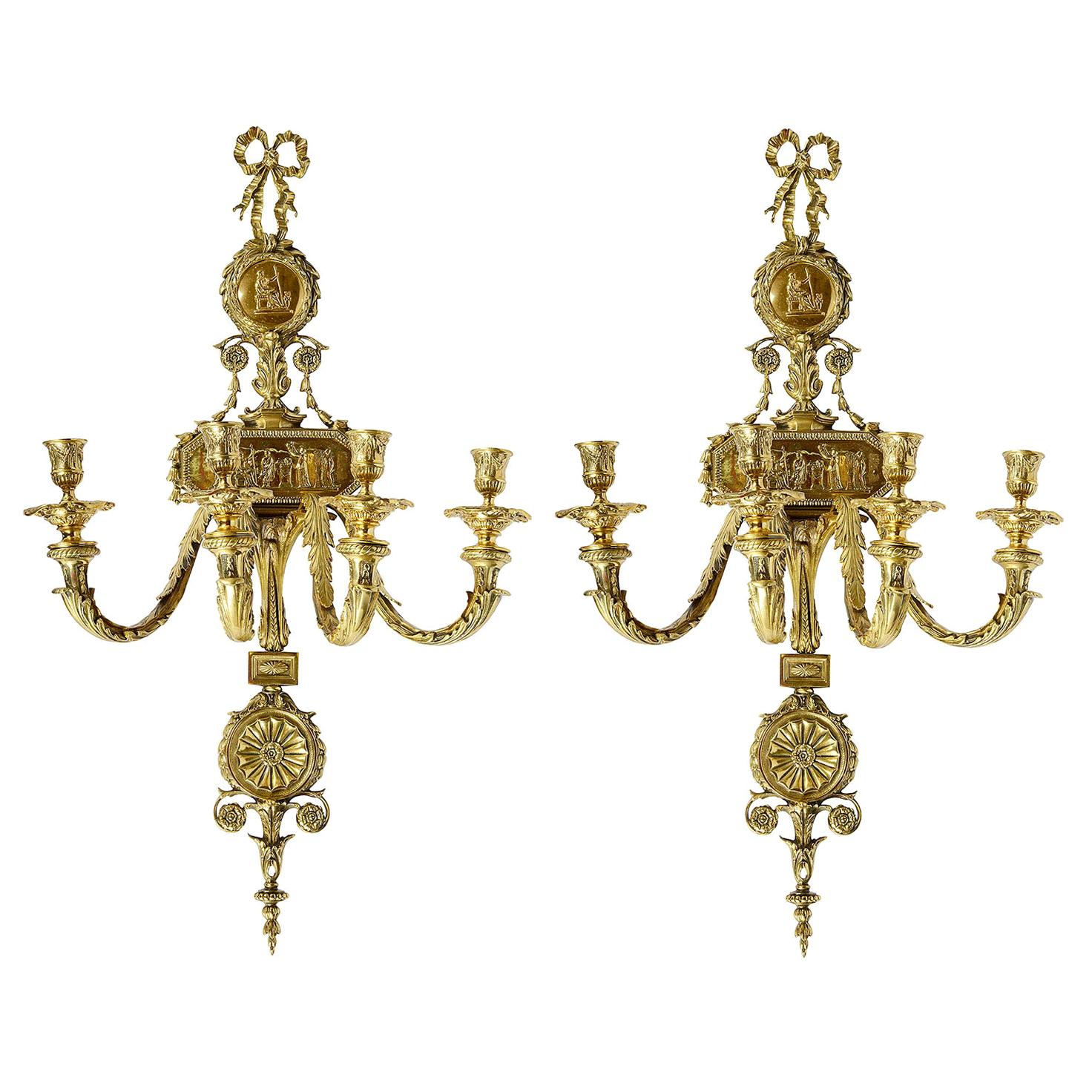Items Similar to French Pair of Napoleon III Ormolu Wall-Lights after Jean-Charles Delafosse
Want more images or videos?
Request additional images or videos from the seller
1 of 10
French Pair of Napoleon III Ormolu Wall-Lights after Jean-Charles Delafosse
About the Item
19th Century French Pair of chiseled and gilded bronze wall-lights, the fluted barrel, from which acanthus leaves escape in scrolls forming two arms of light, and crowned with a fire pot, neck-shovels with twisted flutes, heart, hoes with leaves of water.
Circa 1880
Parisian quality work of the late nineteenth century after a model by
Jean-Charles Delafosse (1734-1791), famous french architect, ornamentist and painter.
Original gilding
Electrified
H 40 cm L 36 cm P 20 cm
The model of our sconces takes the creations of 18th century bronzers who were directly inspired by the drawings of Jean-Charles Delafosse in the 1760s. In particular, the collection of engravings entitled “Nouvelle iconologie historique, or Attributs hiéroglyphiques”, published in 1768, which gives models that present the same volutes then flanking a barrel as those forming the two arms of light of our sconces.
Jean-Charles Delafosse; 1734-1791. Architect, ornamentist, French painter was above all an architect who knew how to deploy all his originality in the ornament, he is known for his collections of architectural models. Important theorist of the Louis XVI style «square» and the beginnings of neo-classicism. His influence is noticeable in the decor of Parisian houses in the years 1760-1780.
- Similar to:Jean-Charles Delafosse (Designer)
- Dimensions:Height: 16.54 in (42 cm)Width: 9.85 in (25 cm)Depth: 5.52 in (14 cm)
- Sold As:Set of 2
- Power Source:Hardwired
- Voltage:220-240v
- Lampshade:Not Included
- Style:Louis XVI (In the Style Of)
- Materials and Techniques:
- Place of Origin:
- Period:
- Date of Manufacture:circa 1880
- Condition:Wear consistent with age and use.
- Seller Location:Saint-Ouen, FR
- Reference Number:1stDibs: LU2612337829952
About the Seller
4.9
Vetted Seller
These experienced sellers undergo a comprehensive evaluation by our team of in-house experts.
1stDibs seller since 2017
56 sales on 1stDibs
Typical response time: 1 hour
- ShippingRetrieving quote...Ships From: Saint-Ouen, France
- Return PolicyA return for this item may be initiated within 2 days of delivery.
More From This SellerView All
- Pair of French Napoléon III Curule ArmchairsLocated in Saint-Ouen, FRPair of French Napoléon III Curule Armchairs Moulded, carved, blackened wood, enhanced with gold. Open-banded back decorated with interlacing, X-bas...Category
Antique 1890s French Napoleon III Armchairs
MaterialsWood, Trimming
- A French Napoléon III Ormolu Cartel Clock by Susse Frères Paris circa 1870By Susse FreresLocated in Saint-Ouen, FRA French 19th Century Cornucopia Gilt-Bronze Cartel, by Susse Frères Paris An Ormolu Cartel in the shape of an escutcheon, with a circular white enamel dial, signed Susse Frères/A Paris, Arabic numerals for the hours and for the minutes. It's bordered by a frieze of pearls and surmounted by a falling laurel knot with a drapery in the lower part and flanked by cornucopias adorned with flowers and fruits. Rectangular base decorated with a garland of knotted flowers dying in a tapered, fluted barrel and damping, in the upper part, a flowery Medici vase. Louis XVI Style Circa 1870 Original gilding uncleaned The Susse company, a worldwide reknown foundry, began to cast pieces as soon as the first half of the 19th Century. Awarded medals...Category
Antique 1860s French Louis XVI Wall Clocks
MaterialsOrmolu
- French 19th Century Ormolu Chandelier After André-Charles BoulleBy André-Charles BoulleLocated in Saint-Ouen, FRA Louis XIV style ormolu eight-lights chandelier, after the famous model by Andre-Charles Boulle An Ormolu Eight-lights Chandelier, each arm held by Ind...Category
Antique 1870s French Louis XIV Chandeliers and Pendants
MaterialsOrmolu
- A Very Fine Quality 19th Century French Pair of CandlesticksLocated in Saint-Ouen, FRVery Fine French 19th Century Pair of Candlesticks In ormolu, very finely chiseled and decorated with knotted garlands, branches of leafy flowers, spokes of hearts, leaves of water...Category
Antique 1870s French Louis XVI Candlesticks
MaterialsOrmolu
- Pair of Porcelain Vases Ormolu-Mounted in Lamps by Gagneau Paris XIXth CenturyBy Gagneau ParisLocated in Saint-Ouen, FRPair of large Japanese Porcelain Cone Shape Vases with Imari decoration Important mounts in ormolu and gilded metal, the base decorated with a laurel wreath, the upper part of falling leaves and a frieze of knotted ribbon. The mounts signed Gagneau, 115 R. Lafayette. Circa 1860 With their original aluminium bulb cover and original gilding Vase it self Height 47 cm The Gagneau Company is one of the most famous lighting factories in Paris in the nine-teenth century, established in 1800 at 25 rue d'Enghien in Paris and later at 115 rue de Lafayette. She has participated in many exhibitions throughout this century. She began in 1819 with the Exposition des Produits de l'Industrie and later participated in the Universal Exhibitions where she was part of the jury in the category of art bronzes (class 25) at the Universal Exhibition in Paris in 1889. "Imari" was simply the trans-shipment port for Arita wares, from where they went to the for-eign trading outposts at Nagasaki. It was the kilns at Arita which formed the heart of the Japanese porcelain industry. Arita's kilns were set up in the 17th century, after kaolin was discovered in 1616. A popular legend attributes the discovery to an immigrant Korean potter, Yi Sam-Pyeong (1579–1655), although most historians consider this doubtful. After the discovery, some kilns began to produce revised Korean-style blue and white porcelains, known as Early Imari, or "Shoki-Imari". In the mid-17th century, there were also many Chinese refugees in northern Kyushu due to the turmoil in China, and it is said that one of them brought the overglaze enamel coloring technique to Arita. Thus Shoki-Imari developed into Ko-Kutani, Imari, and later Kakiemon, which are sometimes taken as a wider group of Imari wares. Ko-Kutani was produced around 1650 for both export and domestic market.Kutani Ware is characterized by vivid green, blue, purple, yellow and red colors in bold designs of landscapes and nature. Blue and white porcelain pieces continued to be produced and they are called Ai-Kutani. Ko-Kutani Imari for the export market usually adopted Chinese design structure such as kraak style, whereas Ai-Kutani for the domestic market were highly unique in design and are ac-cordingly valued very much among collectors. Ko-Kutani style evolved into Kakiemon-style Imari, which was produced for about 50 years around 1700. Kakiemon was characterized by crisp lines, and bright blue, red and green designs of dramatically stylized floral and bird scenes. Imari achieved its technical and aes-thetic peak in the Kakiemon style, and it dominated the European market. Blue and white Kakiemon is called Ai-Kakiemon. The Kakiemon style transformed into Kinrande in the 18th century, using underglaze blue and overglaze red and gold enamels, and later additional colors. Imari began to be exported to Europe when the Chinese kilns at Jingdezhen were damaged in the political chaos and the new Qing dynasty government halted trade in 1656–1684. Ex-ports to Europe were made through the Dutch East India Company, and in Europe the des-ignation "Imari porcelain" connotes Arita wares of mostly Kinrande Imari. Export of Imari to Europe stopped in mid-18th century when China resumed export to Eu-rope, since Imari was not able to compete against Chinese products due to high labor costs. By that time, however, both Imari and Kakiemon styles were already so popular among Eu-ropeans that the Chinese export porcelain copied both, a type known as Chinese Imari. At the same time, European kilns, such as Meissen and English potteries such as Johnson Bros. and (Royal) Crown Derby, also imitated the Imari and Kakiemon styles. Export of Imari surged again in late 19th century (Meiji era) when Japonism flourished in Europe.Thus, in the western world today, two kinds of true Japanese Imari can...Category
Antique 1880s French Japonisme Table Lamps
MaterialsBronze
- A French 19th Century Pair of Louis XVI Style Large Curule StoolsBy Georges Jacob, Maison JansenLocated in Saint-Ouen, FRA French 19th Century Pair of Large Rectangular Curule Stools Gilt and carved wood, decorated with interlace frieze, acanthus leaves and rosaces The 4 feet linked by a gadrooned stretcher. Louis XVI Style Napoléon III Period In the manner of Georges Jacob (1739-1814) Attributed to Maison Jansen Circa 1900 Used Petit Point Tapestry Upholstery Maison Jansen, the French luxury: Opulence, refinement, audacity of style marriages… so many words agree with Maison Jansen. Through this name, a whole era sounds like a reminder of a certain French chic… Some names evoke immutable images, atmospheres... Like Jansen, for example. Let’s close our eyes… The 1960s and 1970s are at their peak. France is doing well. It is a country of full employment where everything seems possible. Within the international Jet Set, a carefree crowd of movie stars, public figures, literary idols and crowned heads, we love the Maison Jansen, its taste for styles struck with a good quality exuberance, and its brilliant side. It all began in 1880, when the Dutchman Jean Henri Jansen founded the epon-ymous house in Paris. Jansen is part of the continuity of these world-famous furniture manufacturers and companies that operated under the Second Empire and at the time of the Universal Exhibitions, as the ‘Escalier de Cristal’ teaches. At that time, the Union Centrale des Beaux-Arts appliqués à l'Indus-trie and the Société du musée des Arts Décoratifs merged to form the Union Centrale des Arts Décoratifs. Supported by both gallery owners, collectors and manufacturers, this organi-zation gives the «la» to the whole profession, and in the prevailing politico-ideological slump (France was defeated by Prussia in 1871 and Napoleon III is in exile), the ‘Union Centrale des Art Décoratifs’ focuses production on the celebration of past styles. While this nostalgia evokes memories of an era that we imagine more stable, an innovative exoticism will be all the rage: the reign of Turkish style and Japonisme. The Jansen house masterfully rushed into the «exotic» trend, but quickly de-veloped a style derived from the ornamental splendor of the eighteenth, then a little later, so-called «imperial» styles mainly intended for royal families. Af-ter the First World War, J.H Jansen was joined by the cartoonist Albert Cazes, by Stéphane Boudin and by Pierre Delbée, who successively directed the house when it disappeared in 1929. At the end of the Kennedy era, Boudin complete-ly redecorated the White House, at the request of the First Lady, Jackie, who had fallen in love with his work after discovering it at Malmaison. In 1971, Jansen joined forces with Leleu-Deshays and continued its quest for excellence. From 1969 to 1979, the dandy decorator Serge Robin took the reins of the house, granting it an eclectic and luxurious style: he revisited the great eras of French art, from the Renaissance to Louis XVI, by modernizing them with more contemporary pieces in Plexiglas or wrought iron. His recomposed and sophisticated style met with resounding success. When Jackie Kennedy, who became the wife of the great Greek shipowner Aristotle Onassis, moved to France, the young architect married Louis XVI-style furniture to modernist designs from the 1950s. When the Shah of Iran decided to celebrate the 250th anniversary of the Per-sian Empire in 1971, Serge Robin and his teams turned to the grandiose and ephemeral setting of Persepolis. A hundred semi-trailers then left the work-shops on Rue Saint-Sabin to reach Tehran. At the same time, Princess Soraya of Iran commissioned her a sumptuous palace for Avenue Montaigne, the princes Faisal bin Fahd of Arabia and Mubarak Al-Sabah, and the Agnelli snatched it. On the French side, he puts his talent at the service of Brigitte Bardot, for whom he completely revamped the Madrague and the Lannes boulevard. Serge Robin embodies all the audacity of the name Jansen with the most im-probable weddings. With him, Plexiglas tables, Japanese chairs from the 50s, gold thread curtains, zebra sofas...Category
Antique 1890s French Louis XVI Stools
MaterialsTapestry, Wood, Giltwood
You May Also Like
- Monumental Pair of Louis XVI Gilt Bronze Wall Sconces Jean-Charles DelafosseBy Jean-Charles DelafosseLocated in London, by appointment onlyFrance, circa 1775. The rarity and importance of this magnificently grand and opulent pair od sconces cannot be overstated, they are without question the finest example you will see...Category
Antique Late 18th Century French Louis XVI Wall Lights and Sconces
MaterialsBronze, Ormolu
- A pair of Napoleon III two-branch ormolu wall lightsLocated in Lymington, HampshireA pair of Napoleon III two-branch ormolu wall lights, each in the form of a tied ribbon supporting a stem of fruiting vines and foliage with gadrooned drip trays and acanthus carved ...Category
Antique Mid-19th Century French Napoleon III Wall Lights and Sconces
MaterialsOrmolu
- Large Pair of French Napoleon III Bronze Wall Lights, 1880-1890By Henri PicardLocated in Saint-Amans-des-Cots, FRLarge pair of French Napoleon III wall sconces, France, 1880-1890. Gilt bronze fixtures and opalescent granite glass shades. Height : 45cm (17.7"), Width : 15cm (5.9"), Depth : 29cm ...Category
Antique 1880s French Napoleon III Wall Lights and Sconces
MaterialsBronze
- Superb Pair of French Ormolu Wall LightsLocated in Chillerton, Isle of WightA Superb pair of French Ormolu Wall Lights A very handsome pair of French wall lights, the lights are designed like an Olympian torch with...Category
Vintage 1960s Adam Style Wall Lights and Sconces
MaterialsMetal
- Pair of Monumental Wall Appliques Napoleon III After J.-B. KlagmannLocated in Berlin, DEPair of monumental wall appliques Napoleon III after J.-B. Klagmann Total weight approximate 140 kg. Solid bronze, electrically mounted, a bronze frame with 3 main branches in a 2-tier crown shape, each main branch comprises fully plastic cast...Category
20th Century French Wall Lights and Sconces
MaterialsBronze
- Large Pair of French 19th Century Ormolu Wall LightsLocated in Brighton, SussexA very impressive pair of late 19th century French ormolu four branch wall lights, each with classical scenes depicted in the plaques, scrolling foliate, and ribbon decoration.Category
Antique Late 19th Century French Louis XVI Wall Lights and Sconces
MaterialsOrmolu
